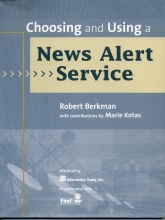
| Home News Releases | Calendar Contact |
Sources Bookshelf

Choosing and Using a News Alert Service
Berkman, Robert
Publisher: Information Today and Find/SVP, Medford, USAYear Published: 2004
Pages: 118pp ISBN: 1-57387-224-5
Please see our media profile in Sources:
Sources Select Resources
Berkman is not identified in this book, but he appears to be the same Robert Berkman who has written information retrieval and reference books for the past twenty-five years or so. The date of publication here is actually August 2004, so it is really current. Overall, there are 81 pages of text; the balance is comparative tables. News alerts are E-mail messages that keep you current on any themes you tell such a service to do for you. You'll want to keep ahead of the competition, so time is of the essence. His definition: news alerts services scan and index text for subscriber's keywords, and automatically alert subscribers to those news items. The idea is not new: twenty years ago there used to be FAX alert services (in fact, Sources was poised to get involved at one point).
Now, text comes from all over the Web: trade journals, online news, blogs, audio-visual clips, Usenet, Web forums, Listservs, both domestic and international, and in different languages - sometimes with machine-generated translations. Usually, several thousand different news sites and sources are scanned.
For businesses, you can track news on specific companies, products, and general industry news.
The news alerts filter the vast amount of news on the web today, producing "niche news". The next step is wireless alerts for all phones: Yahoo! Mobile, AP, ABC News are already there#
The best news alerts are obviously the ones that charge a fee, or are part of a fee-based online subscription service. They can afford the resources for powerful keyword search options. So you get what you pay for. In general, RSS readers, Web page monitors, E-mail newsletters, and TOC (tables of contents) alert services are free. To get prime value, in terms of quantity, quality or depth, you must pay. It costs the news alert service money to implement its product, such as using proximity searching, and to provide customer support. Free services, which use advertising, can only pay a few bills. Berkman reviews and compares the feature/price quality ratios of twenty news alert services, commenting on how well they performed. There are many tables and plenty of screen shots, mostly dated from 2003. There is no index, but there are lists of key business news sources.
Audience or interest level: news junkies, business people who require up to the minute ticker data.
Some interesting facts: Most of us will only want to know his findings: his top picks are Google News Alerts (free), NetContent/Intellisearch (cheap), Dialog NewsEdge (premium) and Lexis/Nexis (also premium).
What I don't like about this resource: no ID for Berkman, Also, the Web is in a state of flux. A few news alerts had closed shop since the book began to be written.
What I do like about this resource: he notes that my old research buddies Dialog and Nexis are still around and have moved into the news alert business, still charging fees. Nothing has been able to beat them since they began operating over a quarter of a century ago. Berkman notes some material on "specialized" news alert services that scan items such as new patent filings, recent mergers, and company filings. Most can be free, especially for sending you the announcement. If you want details, you'll need to pay a modest price.
Quality-to-Price Ratio: if this is the usual corporate report, as a tax-deductible expense, give it an 85.
[Review by Dean Tudor]
© Sources 2023. The information provided is copyright and may not be reproduced in any form or by any means (whether electronic, mechanical or photographic), or stored in an electronic retrieval system, without written permission of the publisher.